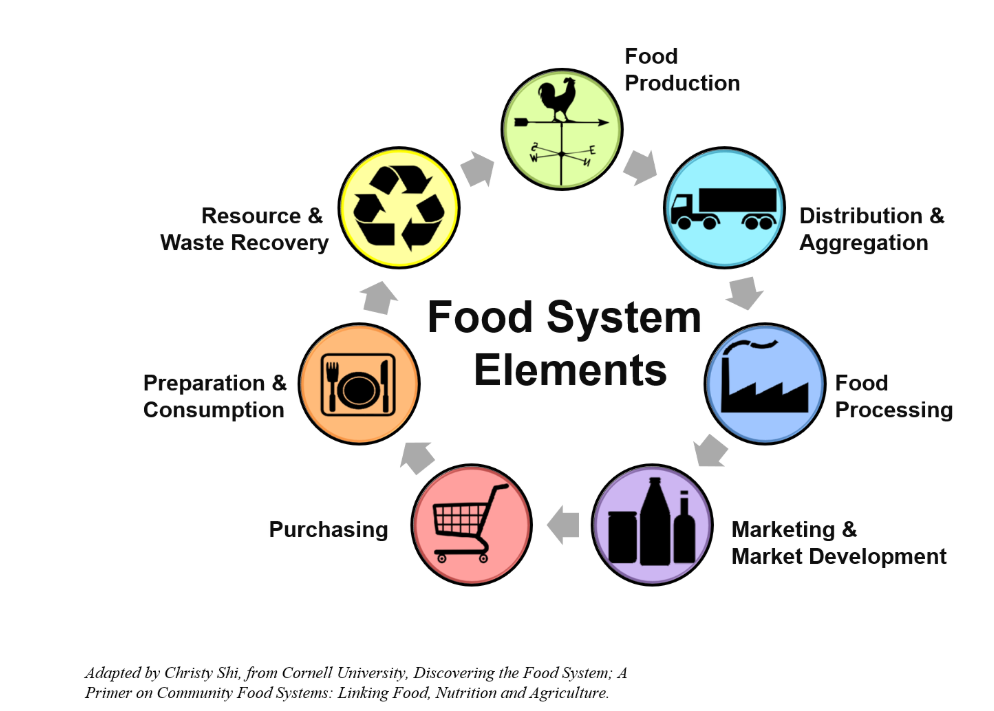Pandemics, climate change, and shifting economic conditions continue to create uncertainty and to expose the vulnerability of our global supply chains. As a result, many communities are turning to their regional food systems to build and strengthen local resilience. Local and regional food system development is gaining recognition as a tool for improving sustainability, promoting health equity, and advancing local economic development.
Why Local Food Systems?
When we talk about food systems, we are talking about the interconnected web of resources, activities, and processes that move food through the cycle of production, processing, distribution, retail, consumption, and disposal. Over the last several decades, we have seen a shift to a globalized food system that operates on a massive global scale and values efficiency above all else. While this change has helped expand our diets, it has also come at the expense of our environment, our health, our local economies and self-reliance. In contrast, local and regional food systems operate on a smaller geographic scale. They value sustainability, high quality food, living wages, safe working conditions, and reinvestment in the local economy. By keeping all elements of the food supply chain local, a strong local food system can even reduce costs for consumers, creating more equitable access to nourishing foods for all people.

The Challenge and the Opportunity
While there are many groups advocating for changes in policies, systems, and financing that would better support the development of local and regional food systems, challenges still remain. New and small farmers report a lack of access to available and affordable land. Infrastructure creates another barrier. Those looking to start or grow a food aggregation, distribution, or processing business require space that can accommodate temperature-controlled storage and/or processing equipment. In order to be successful, they also need to be situated strategically with proximity to both farms and retail markets. Without this foundational infrastructure, local food systems are unable to grow.
We believe that airports have the potential to fill some of these gaps as they provide a number of important resources.
- Land – Many airports own land that is not required or not suitable for aeronautical purposes. This could be due to noise or stormwater management requirements, terrain, or closure of facilities such as runways or taxiways. Maintenance of these spaces use valuable airport resources. Depending on the situation, land could be sold or leased directly to local farmers or to nonprofits, generating revenue instead of expenses. Innovative uses could include incubator farm plots for beginning farmers or demonstration gardens used to test new growing techniques or food varieties. Even surprisingly small spaces between other airport facilities could be used for intensive production, for example in greenhouses or apiaries.
- Buildings – In addition to land, many airports also have vacant buildings on their property that are no longer needed for aeronautical purposes. Hangars and warehouse-type structures are well-suited for food storage, processing, and packaging activities and could be leased or sold to these types of businesses. Small farmers typically do not have adequate space or equipment to be able to store their products for extended periods of time. This limits their ability to compete in larger, more profitable markets. Access to shared storage space creates opportunities for individual farmers to scale up their operations or for multiple farmers to pool their products so they can sell to larger buyers.
- Transportation infrastructure – Designed to move people and goods safely and efficiently, airports already have transportation infrastructure that makes it easy to get around. Beyond runways and taxiways, airports have roads that can accommodate trucks and large vehicles on airport property. And they have easy access to major highways and often offer public transit options that connect travelers and workers to surrounding communities. Typically sited near large metropolitan areas, but far enough away from densely populated areas, they provide the perfect location for food system development activities that require proximity to both rural farms and larger food retail markets.


Avoiding Hurdles
Any non-aeronautical land use on airports must not introduce unacceptable risk to aircrafts or people on the ground, and it must not hinder the operation and growth of the airport. In addition to possibly creating unsafe conditions, non-aeronautical land uses have the potential to jeopardize investments that have been made in the airport through government grants and/or private investments.
One of the most difficult problems that agricultural operations face on airports is the potential for wildlife attraction. Birds are particularly problematic for aircrafts, but other wildlife such as deer present hazards as well. It is crucial that potential problems with wildlife attraction be identified early and appropriate plans developed to mitigate these problems. The FAA maintains a page with wildlife regulations, guidance and resources that can help anyone considering projects on or near airports that could attract wildlife.
Reaping the Benefits
With various potential complications, you may be wondering why airports would even consider using their land and buildings for non-aeronautical uses such as agriculture. The reason is that it benefits the airport in several ways. First, property sales or leasing agreements help to bring in additional revenue important to the airport’s bottom line. Similarly, it reduces maintenance costs by eliminating the need for mowing on vacant land or upkeep of vacant buildings. Finally, these types of community-airport collaborations create opportunities for positive press and improved community relations.
Increasing Local Impact
While agriculture at or around airports is not new or uncommon, we see potential for increased impact by intentionally positioning airports as a partner in local food system development efforts. The land and infrastructure they provide are tied to every element of the food supply chain and critical for building local capacity. We believe that building stronger relationships between airports and food system stakeholders could create a world of new possibilities with social, environmental, and economic benefits that span far beyond the partners directly involved. These partnerships are a potential opportunity to increase the resilience of both airports and the communities they serve.
At cepa consulting, our experience in both food system development and airport planning make us uniquely qualified to facilitate this type of collaboration. We strive to be a connector, bringing people together across sectors and communities to navigate the human and technical challenges you may face in making your vision a reality. Whether you are an airport operator or a local food system advocate, we hope you will reach out to us to share your thoughts and ideas. We are eager to explore possibilities together!

Leave a Reply